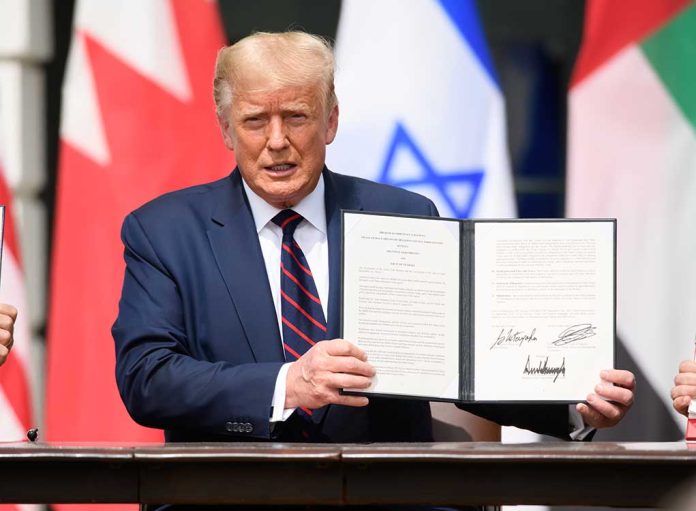
President Trump signed a sweeping executive order to dissolve the Department of Education, fulfilling a long-standing Republican goal, but the path forward involves legal hurdles and congressional approval.
Key Takeaways
- President Trump signed an executive order directing Education Secretary Linda McMahon to begin dismantling the Department of Education, returning educational authority to states.
- The department cannot be immediately closed without congressional approval, though Trump has already reduced staff from 4,133 to 2,183 employees.
- Critical functions including Pell grants, Title I funding, and resources for children with disabilities will be preserved and redistributed to other federal agencies.
- The White House cited the department’s $3 trillion spending since 1979 with minimal improvement in student achievement as justification for the change.
- Democrats, teachers unions, and consumer advocates are expected to challenge the order through lawsuits, citing concerns about civil rights enforcement and educational quality.
A Fulfillment of Republican Ambitions
The dismantling of the Department of Education has been a Republican goal since its creation during President Jimmy Carter’s administration in 1979. Trump’s executive order represents the most significant step toward this objective, directing Education Secretary Linda McMahon to orchestrate the department’s closure while ensuring the “effective and uninterrupted delivery of services, programs, and benefits on which Americans rely.” Trump emphasized the importance of this task during the signing ceremony, telling McMahon, “Linda, you’re going to be presiding over something that’s so important.”
The administration justified the move by pointing to disappointing educational outcomes despite massive federal spending. According to White House statements, the Department of Education has spent over $3 trillion since its establishment, yet American students continue to show low proficiency in fundamental subjects. Trump and his allies argue that decentralizing education governance will allow states to implement more effective, locally-tailored approaches to education.
#Liberal #Meltdown : #PresidentTrump signs #executiveorder dismantling the #DeptofEducation at the Federal level, bringing it back to the State level. The #DOE clearly hasn’t worked. Despite a 600% spending increase, #reading and #math #competency scores have been going down. pic.twitter.com/QP9wpZ8nPX
— Sn00pdad (@sn00pdad) March 20, 2025
Phased Implementation with Significant Hurdles
Despite the dramatic announcement, the executive order does not immediately abolish the Department of Education. Complete dissolution requires congressional approval, presenting a significant challenge even with narrow Republican majorities in both chambers. The order instead initiates a process that includes transferring essential functions to other federal agencies, potentially converting federal education funding into block grants with fewer conditions, and developing a comprehensive proposal for Congress.
While the department currently manages a $268 billion budget (approximately 4% of the U.S. federal budget), its responsibilities are vast. These include overseeing $1.6 trillion in student loans, distributing billions for K-12 education through Title I funding, enforcing civil rights in educational settings, and administering programs for students with disabilities under the Individuals with Disabilities Education Act (IDEA).
Preserving Critical Functions While Transferring Authority
Trump has assured the public that “useful functions” such as Pell grants, which provide financial aid to low-income undergraduate students, will continue. Plans include shifting responsibilities to other federal departments. The Treasury might take over student loan operations, while the Labor Department could manage career and technical education programs. Civil rights enforcement would likely transfer to the Department of Justice, potentially resulting in fewer investigations into discrimination complaints in educational settings.
The administration has already taken concrete steps toward downsizing the department, having laid off nearly half its staff since Trump took office. Education advocates warn that this rapid dismantling could disrupt essential services for millions of students and families who rely on federal programs. Some Republican proposals suggest allowing Title I funding, traditionally reserved for schools serving low-income populations, to be used for private schools, a shift that raises additional concerns about civil rights protections.
The Road Ahead
As the administration moves forward with its plans, legal challenges are expected from Democrats, teachers unions, and progressive organizations. These groups argue that the federal department plays a crucial role in ensuring educational equity across the country. The ultimate fate of the Department of Education will depend on congressional action and the outcome of inevitable court battles, creating uncertainty about the future landscape of American education governance.
Trump has compared his vision for American education to systems in countries like Denmark, Norway, and Finland, which consistently rank higher in international assessments. By returning authority to states, the administration believes American education can achieve similar success through locally-driven innovation rather than federal mandates. Whether this approach will lead to improved educational outcomes remains a hotly debated question as the process unfolds in the coming months.
Sources:
IT’S DONE: Trump Signs Monster Executive Order Aimed at Closing Education Department
What to know about how Trump’s executive order will affect American education
Trump signs executive order aimed at dismantling U.S. Department of Education













